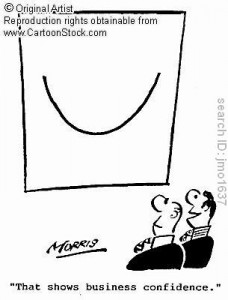The Western Electric company was giving its workers practically everything – the latest pension plans, sick and other benefits, recreational programmes, but still things were not going well. Somebody thought, office lighting had to something to do! The company engaged some research people to study the effect of lighting on production. The researchers selected two groups of operators. The first group was kept working under the old amount of light and the second group was given more light. With more light, output increased as expected. But surprisingly, the output of group first also went up! Group second was given less light to work while the output still went up and so did the other groups. Finally, they put two workers in a room without any light at all, working by sense of touch completely in the dark. Despite this handicap the workers kept up the increased output.
This was a puzzle!!!
Research workers experimented further, they isolated a study group of give women workers. For a year and a half, they checked the girl’s production under different conditions (its just work production! n nothing else :P). The gilrs were given two five minutes’ rest periods, output went up. Two ten minutes’ rest periods, output went up still. Then 15 min and the girls were served a hot snack, the output was up again. The girls were let off half an hour earlier, still the output soared higher. It remained on that high level when their weekly hours were cut from 48 to 40. As a test, the scientists restored the original conditions. The girls went back to time work, no rest periods no hot snack and 48 hrs a week, the result: output hit all time high.

A skilled statistician spent several years trying to relate variations in output with variations in physical circumstances of the five operators. The attempt to relate changes in physical conditions to variations in output resulted in not a single correlation of enough statistical significance to be recognized by any competent statistician as having any meaning. The investigators were forced to the conclusion that human situations are likely to be complex. The girls who were being experimented upon were not stones and they were unaware of the fact that they were being experimented upon. The attitude of the subject to the experiment is an important factor in determining the response to situation. The result led to the inevitable conclusion that whether or not a person is going to give his services whole heartedly to the group depends in good part on the way he feels about his job, his fellow-co workers and supervisors.
A new line of approach was therefore adopted. A few experimenters went in to the shops to talk to the workers and to get to know them. It was discovered that a person can talk about what is uppermost in the mind. Even the complaints were listened to carefully. Quite a few of the complaints were investigated and set right, but several times the experimenters did absolutely nothing about the object of the complaint, but, after the interview, curiously enough, the complaint disappered. They found that some people did not really want anything done about difficulties of which they are complaining.
“They just wanted an opportunity to talk about their troubles to a sympathetic listener. ”
This led to a further re-thinking on the subject. The notion of the economic man , man primarily motivated by economic interests was shaken. The conception of the worker was changed. The experiments indicated that the behavior of workers could not be understood apart from their feelings and sentiments. Secondly, it was found that sentiments were easily disguised. Thirdly, the manifestations of sentiments could not be understood as things in and by themselves, but only in terms of the total situation of person. (This doesn’t in any way be taken that i am not looking for a salary hike. Actually I’m desperate for it. Social situation isn’t it! :P)
Response to work, to a change depends on conditioning of the sentiments, the kind of human satisfaction he is deriving from his social participation with other workers and supervisors in the immediate work group of which he is a member and hence, the effect of the change on his customary interpersonal relations. The worker is not an isolated atomic individual. He is a member of a group. Within each of these groups, the individual has feelings and sentiments towards each other which bind them together in collaborative efforts. It was found that operating within this group were four basic sentiments: You should turn out too much work, if you are, you are a rate buster; you should not turn out too little work, if you are, you are a chiseller. You should not say anything to the supervisor which would react to the detriment of one of your associates. If you are,you are a squealer. You should not be too officious. If you are an inspector, you should not act like one. To be an accepted member of a group, a man has to act in accordance with these social standards.

The experiments further considered the possibility that differences in individual performances might be related to difference in abilities. They compared each workers’ relative rank in output with his relative rank in intelligence and dexterity as measured on certain tests. The results were interesting. The lowest producing in te room ranked first in intelligence and third in dexterity. The highest producing in the room was seventh in dexterity and lowest in intelligence. This did not seem to make sense. The researchers thought there must be other factors which explained individual differences. They started studying the beliefs and creeds, their social codes and norms of behavior, the important social functions these groups perform , the history of these groups.
The important points these experiments summarized were: workers were not isolated and unrelated individuals. They are social animals and should be treated as such. It is further evident from the methods of handling them are still archaic. We must obtain a new understanding of human motivations and behavior in an organization. Each person is unique and brings to his job certain attitudes, benefits and ways of life as certain skills: technical, social and logical !

After seventy years of these experiments, the points still hold true. Perfectly true.
If you like this discussion, please let me know and I would discuss more on human work motivation and the impact of salary in my next post.
(Background information: Some studies were made in the Hawthorne plant, a manufacturing unit of the Western Electric Company at Chicago which itself was a part of the Bell telephone and Telegraph System with headquarters at Philadelphia, by a team from the Harward Business School under the leadership of Elton Mayo. The experiments were spread over a period of 16 yrs (19230-39) and are probably “the most famous consciously planned experiments in the history of social science to date.” )
Related Posts
Love playing Tennis. Love Movies











Hi Bharath , thank you for the encouragement. We would try and post out on the topic you mentioned. Stay tuned.
Thank you !
please do write on salary and personnel motivation. U explain it in a simple way. nice..plzz continue